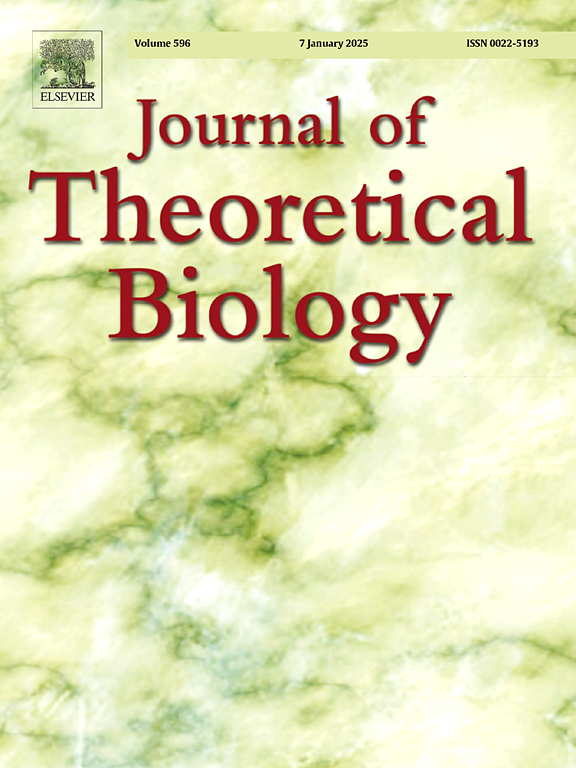The impact of contact-network structure on important epidemiological quantities of infectious disease transmission and the identification of the extremes
IF 1.9
4区 数学
Q2 BIOLOGY
引用次数: 0
Abstract
An individual-based stochastic model was developed to simulate the spread of an infectious disease in an SEIR-type system on all possible contact-networks of size between six and nine nodes. We assessed systematically the impact of the change in the population contact structure on four important epidemiological quantities: i) the epidemic duration, ii) the maximum number of infected individuals at a time point during the epidemic, iii) the time at which the maximum number of infected individuals is reached, and iv) the total number of individuals that have been infected during the epidemic. We considered the potential relationship of these quantities as the network changes and identified the networks that maximise and minimise each of these in the case of an epidemic outbreak. Chain-like networks minimise the peak and final epidemic size, but the disease spread is slow on such contact structures which leads to the maximisation of the epidemic duration. Star-like networks maximise the time to the peak whereas highly connected networks lead to faster disease transmission, and higher peak and final epidemic size. While the pairwise relationship of most of the quantities becomes almost linear, or inverse linear, as the network connectivity increases and approaches the complete network, the relationships are non-linear towards networks of low connectivity. In particular, the pairwise relationship between the final epidemic size and other quantities is changed in a ‘bow-shaped’ manner. There is a strong inverse linear relationship between epidemic duration and peak epidemic size with increasing network connectivity. The (inverse) linear relationships between quantities are more pronounced in cases of high disease transmissibility. All the values of the quantities change in a non-linear way with the increase of network connectivity and are characterised by high variability between networks of the same degree. The variability decreases as network connectivity increases.
接触网络结构对传染病传播的重要流行病学数量和极端情况识别的影响。
我们开发了一个基于个体的随机模型来模拟传染病在6到9个节点之间的所有可能的接触网络中的传播。我们系统地评估了人群接触结构变化对4个重要流行病学量的影响:1)流行持续时间,2)流行期间某个时间点的最大感染人数,3)达到最大感染人数的时间,4)流行期间的感染总人数。我们确定了在流行病爆发的情况下最大化和最小化这些数量的网络。链状网络最大限度地减少了流行病的高峰和最终规模,但疾病在这种接触结构上传播缓慢,导致流行病持续时间最大化。星形网络最大限度地延长了到达峰值的时间,而高度连接的网络导致更快的疾病传播,以及更高的峰值和最终流行规模。当网络连通性增加并接近完整网络(其中每个个体都相互连接)时,大多数数量的成对关系几乎变为线性或逆线性,而对于低连通性的网络,这种关系是非线性的。特别是,最终流行规模与其他数量之间的成对关系以“弓形”方式变化。随着网络连通性的增加,疫情持续时间与疫情峰值规模之间存在较强的逆线性关系。在疾病高传播率的情况下,数量之间的(逆)线性关系更为明显。随着网络连通性的增加,所有量的值都以非线性方式变化,并且在相同程度的网络之间具有高变异性。可变性随着网络连接的增加而降低。
本文章由计算机程序翻译,如有差异,请以英文原文为准。
求助全文
约1分钟内获得全文
求助全文
来源期刊
CiteScore
4.20
自引率
5.00%
发文量
218
审稿时长
51 days
期刊介绍:
The Journal of Theoretical Biology is the leading forum for theoretical perspectives that give insight into biological processes. It covers a very wide range of topics and is of interest to biologists in many areas of research, including:
• Brain and Neuroscience
• Cancer Growth and Treatment
• Cell Biology
• Developmental Biology
• Ecology
• Evolution
• Immunology,
• Infectious and non-infectious Diseases,
• Mathematical, Computational, Biophysical and Statistical Modeling
• Microbiology, Molecular Biology, and Biochemistry
• Networks and Complex Systems
• Physiology
• Pharmacodynamics
• Animal Behavior and Game Theory
Acceptable papers are those that bear significant importance on the biology per se being presented, and not on the mathematical analysis. Papers that include some data or experimental material bearing on theory will be considered, including those that contain comparative study, statistical data analysis, mathematical proof, computer simulations, experiments, field observations, or even philosophical arguments, which are all methods to support or reject theoretical ideas. However, there should be a concerted effort to make papers intelligible to biologists in the chosen field.

 求助内容:
求助内容: 应助结果提醒方式:
应助结果提醒方式:


